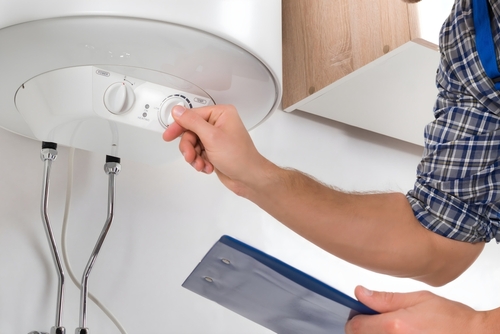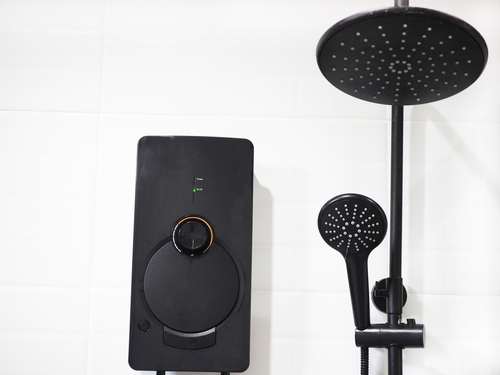July 2, 2025
How to Flush a Water Heater
Nearly every home has a water heater—but not many homeowners know that flushing your water heater is an essential part of its maintenance. The simple task removes impurities from your water heater, helping it remain efficient and live a longer life.
So, what is a water heater flush, and how do you do it? Read on to learn more.
Why Flush Your Water Heater?
Throughout its lifespan, your water heater collects impurities from the water supply. Calcium, rust, and sand build up, which means your machine has to work harder to heat water. Let them collect too long, and you risk your water heater going cold, having to replace it sooner, and perhaps adding to your energy bills.
Luckily, flushing your hot water heater takes only an hour. Take care of it on a Saturday afternoon, and you’ll be rewarded with a fresh, clean appliance the rest of the year.

How to Flush a Water Heater
- Turn your thermostat to the vacation setting.
Most water heaters have a vacation setting. This turns the temperature of your water down while you don’t need it. If your water heater doesn’t have a vacation setting, simply turn the thermostat as low as it goes.
- Shut off the cold water supply valve.
Your water heater will have two pipes above it: one for the incoming cold water and one for the outgoing hot water. Turn off the valve on the incoming cold water pipe to stop more water from coming into your water heater while you flush it.
- Connect a garden hose to your water heater’s drain.
You’ll find a threaded coupling for the drain at the bottom of your water heater. Simply screw your garden hose on as you would with a faucet.
- Open a hot water faucet somewhere in your home.
This vents the hot water line and allows your tank to drain more quickly.
- Place the open end of the garden hose over a floor drain.
Most basements should have a floor drain near the laundry basin. Place your hose over the drain so the water can exit without flooding your basement.
- Open your water heater’s valve.
Use a flathead screwdriver to open the valve where the hot water heater drain connects to the hose. Water should begin flowing.
- Close the valve and disconnect the hose.
Once all the water (and sediment) have emptied out of your water heater, close the valve tightly and remove the garden hose.
- Turn off the hot water faucet and open the cold water valve.
Now you can refill your water heater. This will take a few minutes and the water will automatically stop once it’s full.
- Adjust your thermostat.
Return your thermostat to whatever temperature you prefer. For most homes, that’s around 120 degrees. Your water heater will begin to heat the water, and within an hour, you should have hot water again.

What About a Tankless Water Heater Flush?
Tankless water heaters still need to be flushed to remove impurities and extend their lifespan. The process is similar to a traditional water heater flush, but there are a few key differences. For one, you’ll need to purchase a tankless water heater flush kit, which includes necessary supplies.
Here’s how to flush a tankless water heater:
- Turn off isolation valves and gas: You’ll know your valves are turned off when they’re perpendicular to the pipe.
- Connect hoses to the inlet and outlet valves: Use pliers to make sure the connection is tight and water won’t leak while flushing.
- Attach the inlet hose to the circulation pump and place the outlet hose in a bucket: The circulation pump will come with your water heater flushing kit.
- Add the cleaning agent: A cleaning agent will also be included in the flushing kit. Add it to the bucket with around 1 gallon of water.
- Open the valves: Start the pump and let it run for at least 45 minutes.
- Flush out the cleaning agent: Stop the pump, turn off both valves, and disconnect the inlet valve hose. Flush out the cleaner by keeping the hose connected to the hot water outlet valve and turning on the cold water inlet valve for around 10 minutes.
- Reconnect: Plug your service port caps back in and turn on both water valves and the gas valve.
How Often Should You Flush Your Water Heater?
Flush your water heater about once a year to avoid sediment buildup and prolong the life of your appliance.
Having Water Heater Problems?
If your hot water heater is old or your drain valve is faulty, it may not seal when you close it at the end of the flush. If you notice problems with your hot water or would like information on a new, energy-efficient water heater for your home, give Applewood a call today.
Our licensed technicians are available throughout the Denver/Boulder area, and they’d be happy to help with your flush and inspect your water heater. Don’t waste time on an inefficient appliance—we’re here to help!


